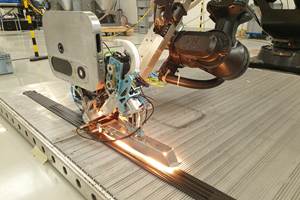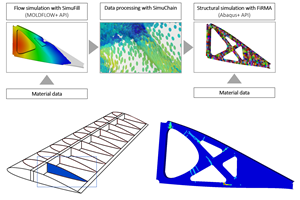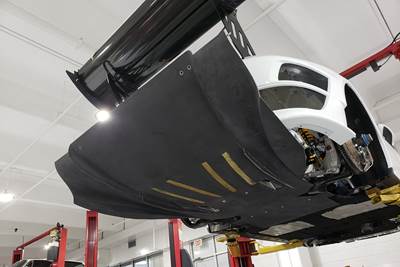Modeling and characterization of crushable composite structures
How the predictive tool “CZone” is applied to simulate the axial crushing response of composites, providing valuable insights into their use for motorsport applications.
Simulation model alongside a complex crash cone structure showcasing the predictive capabilities of CZone in composite materials. Source (All Images) Engenuity Ltd.
The use of composites in the construction of passenger vehicle structures is on the rise, driven by the automotive industry’s need to meet stringent fuel economy regulations and reduce carbon emissions. A noteworthy development is the increasing prevalence of composite impact structures, particularly using carbon fiber-reinforced polymers (CFRP), which have shown impressive energy absorption capabilities per unit mass in motorsport applications.
In contrast to an isotropic metallic structure that undergoes plastic deformations through a variety of buckling and folding mechanisms to absorb kinetic energy during a crash, a composite subjected to axial compressive forces progressively disintegrates from one end to the other as the crush front travels along its length. These structures effectively dissipate energy via a crushing mechanism during high impact axial loading events, thereby mitigating the resultant large accelerations and forces.
Shown here is a composite structure specimen used for CZone testing that mimics the size and shape of an automotive crash structure, complete with section changes, inserts and a through-hole feature commonly seen in such configurations.
However, the behavior of composite materials during crushing is highly intricate, involving a multitude of complex micro-interactions between the fibers and the surrounding matrix. In addition, accurately and conveniently analyzing the behavior of composite materials in crash situations has historically been a major hurdle, limiting the widespread use of composite structures in road vehicle applications. Conventional finite element analysis (FEA) tools have faced challenges in precisely depicting the failure mechanisms of composite structures due to their complex failure modes, impeding the simulation of their crash behavior and the development of cost-efficient crash structures for road vehicles.
To address this, Engenuity Ltd. (West Sussex, U.K.), an FEA-focused lightweight engineering consultancy owned by HRC (Hengrui Corp., Shanghai, China) created an add-on application for Dassault Systèmes’ (Paris, France) Abaqus-Explicit FEA software program. This application developed over the last decade, called CZone, is specifically designed for accurately simulating composite materials in crash scenarios. It uses a nonlinear explicit FEA approach to achieve this.
“CZone specifically addresses the pressing need for advanced crush simulation for energy-absorbing structures constructed from composites,” explains Ian Coles, technical director at Engenuity UK. “It has been meticulously developed to bridge the gap between experimental observations of a composite material’s energy absorption capabilities in impact scenarios, and the necessity to comprehend and reliably predict complex structural interaction and stability in larger scale crash events.”
CZone background
Coles notes the FEA community has undertaken multiple efforts to develop reliable composite crash simulations over time. “Despite utilizing programs like LS-Dyna, PamCrash, Radioss and others, a comprehensive solution that effectively deals with predicting failure in the composite structure throughout its length and in the area where the material fragments absorb energy at the crush front remained elusive,” he says. “Even the crashworthiness working group of Composite Materials Handbook CMH-17 has encountered difficulties with traditional codes, noting their reliance on non-physical parameter variables and producing very ‘noisy’ force resultants.
“Traditional codes are sensitive to factors such as element size, contact definition, load-penetration curves and crush front softening parameters, among others,” he continues. “As a result, these approaches are unsuitable for predictive analysis, prompting the need to develop a new solution, which has led to the development of CZone.”
CZone recognizes “crush stress” as a unique mechanical property exhibited by composite materials. This crush stress provides continuous resistance when a segment of the composite structure is subjected to impact forces. This resistance functions as the input force for the rest of the composite crash structure within the vehicle FEA model.
Within the Abaqus/Explicit FEA software, CZone is able to generate element force modeling in the crush zone by combining crush stress with other modes of composite failures that are already incorporated in the Abaqus Damage for Fiber Reinforced Composites material model.
Developing data for CZone
CZone’s product development process entails a holistic material characterization approach. It commences with the physical testing of the material and characterization into FEA material cards. Following this stage, an FEA model of the component is generated. This model can then be used to optimize the material layup of the component using CZone and these measured material properties to develop an efficient and safe component to absorb the required energy and achieve desired levels of deceleration.
Coupons are quasi-isotropic and feature a saw-tooth shape at one end to initiate the crushing process.
In determining the crush stress mechanical property, Engenuity conducts physical crush testing on composite coupons that are waterjet cut from flat plaques or sheets of the selected laminate. These coupons are designed explicitly for crush testing with a saw-tooth shape cut into one end to initiate the crushing process.
Crush testing is conducted using a custom-designed test fixture that can be applied in various loading apparatuses, such as Instron’s (Buckinghamshire, U.K.) material impact testing system or Engenuity’s bespoke high-energy drop tower. This test fixture provides lateral restraint against buckling during the crushing process and facilitates the exit of crushed debris without affecting the subsequent crushing response. These tests generate material crush values that are independent of the final composite part and so can be used to predict the behavior of any structure with no further testing of subparts or the final part.
“To achieve optimal energy absorption, the advancing crush front must progress continuously along the length of the composite member,” Coles explains. “This necessitates a deep understanding of the behavior of laminate materials to effectively and reliably design and simulate the operational physics needed for a safe crash structure.” The typical composite crash structure coupons are made using high-strength carbon fiber (glass fiber can also be used) with a thermoset or thermoplastic matrix in a quasi-isotropic laminate comprising 0°, 90°, +45° and -45° for optimal mechanical properties (depending on other externally applied load cases).
Upon the completion of physical testing to characterize the crush properties of the laminate, the data is processed to generate the material-specific crush stress values to be applied within the Abaqus/Explicit FEA software. This ensures an accurate representation of the crush behavior of the laminate material in subsequent virtual simulations and analysis.
Composite crush structure design
In developing a composite crush structure for a vehicle’s impact system, a comprehensive analysis of material properties, geometric design, laminate thickness, fiber orientation and other critical parameters is essential. The crash structure is typically composed of multiple sections, each exhibiting unique behaviors during the crushing operation.

Pre and post-crush analysis of a composite crash structure specimen from a 0° crush test, demonstrating real-world impact damage.
“The crush zone, which refers to the portion of the component impacted by the barrier and extending to where the impact is arrested, plays the most critical role in defining the overall behavior of the entire composite structure,” notes Coles. “During an impact event, the majority of energy absorption and dissipation occurs in this crush zone.”
He adds, “The structural design [here] needs to ensure that the impact structures deform and disperse energy consistently and effectively, thus providing the required deceleration of the vehicle to keep the occupants safe from harm. This requires careful analysis and testing to ensure the structure performs as intended under various impact scenarios.
“It is essential to take into account the combined effects of the various failure modes occurring within the component’s crush zone and the system’s behavior beyond the crush zone,” he advises. “This involves simulating in-plane laminate failure and interlaminar delamination to ensure that the structure is capable of effectively mitigating the impact forces.”
CZone in action
A series of specialized cone test specimens were created to demonstrate the capabilities of CZone software. The specimen mimicked the size and shape of an automotive crash structure, complete with section changes, inserts and a through-hole feature commonly seen in such configurations. A 960-kilogram sled crushed these at a velocity of 10 meters/second to simulate the composite behavior in a crash scenario.
The aim of specimen testing was twofold. On one hand, testing had to show correlation to the crush forces generated at a stable crush front for different layups incorporated into the component. Secondly, it was essential that structural failure away from the crash front could be predicted. “It is crucial to consider the potential for structural damage or failure beyond the primary crush front in the design of crash-worthy composite structures,” notes Coles. “Structural damage or failure in these areas can undermine the structure’s ability to absorb energy. In the case of an abrupt fracture, the potential for further energy absorption is lost with subsequent greater levels of intrusion into the structure.”
For the first case, several tests were conducted on various layups and assessed to measure the crush forces generated during the impact event. In total, 15 different layups were evaluated, having been designed using CZone and the predicted crush force calculated. Test results correlated well with the predicted behavior, showing deceleration forces within 10%.
Graph showing the history of reaction force versus displacement during a sled test, comparing experimental and simulation data.
To fulfill a second set of requirements, it was necessary to ensure that potential failure sites positioned away from the primary impact area were well understood. In order to achieve this, Engenuity designed composite cones using CZone to intentionally fail at a distance from the initial crush zone. By progressively increasing the thickness of the material, they could steadily increase the crush force until the structure behind the primary impact area could no longer withstand the escalating load and would fail. The point at which the applied force caused structural failure coincided closely with predictions, within 10 millimeters of the real-world test.

Simulation and real-world comparison of a composite cone structure post-crash, highlighting predictive accuracy.
The analysis team and CZone were tasked with a final test involving a cone set at a 30° angle to the impact direction. The test required progressive crush throughout the impact event as well as bringing the 960-kilogram sled mass traveling toward the cone at 10 meters/second at a 30° angle to a controlled stop. For comparative purposes, a cone designed for 0° offset was also assessed in the sled at the 30° angle.
“Comparison of the physical test and simulation data revealed that both the physical test and simulation exhibited minimal crushing response due to an early catastrophic fracture between the cone and its backup structure during the impact event. Consequently, very little deceleration of the sled was observed and the sled saver was called in to play on this occasion,” explains Coles.
Comparison of predicted and experimental reaction force histories during a 30° impact angle sled test.
For the main test, a more intricate cone structure — resembling the previous ones but designed using CZone to withstand the loading angle and yet still generate enough crush force to safely stop the sled in a controlled manner — was subjected to the 30° impact angle.
“Despite the similar impact angle as the first test, noticeable crushing occurred in both the physical test and simulation. Crush forces were generated that brought the sled to a controlled stop,” highlights Coles. “The difference in energy absorption between this and the previous example was clear, with the continued resistance resulting from progressive crushing leading to increased reaction forces throughout the event.
Experimental sled test showing the crushing of a complex cone structure, with fractures occurring away from the crush front.
“Without the accurate prediction of crush force enabled with CZone, it wouldn’t have been possible to design the material layup in the transition region structure to withstand these impact events,” Coles adds.
Findings from the experiments
The CZone technology demonstrated a high level of correlation with physical tests of automotive crash structures. “By incorporating measured crush stress properties, CZone is able to accurately simulate the crushing response between a composite structure and an impacting body,” highlights Coles. “Extensive testing across various composite crash structures and load cases has shown a strong correlation between simulation results and experimental test data.”
This correlation effectively predicts the crushing response and enables accurate forecasts of damage and failure in regions not directly at the crush front. The integration of CZone technology within the Abaqus/Explicit FEA software has the potential to significantly contribute to the design of large-scale composite structures with strict crashworthiness and energy absorption requirements. “As industries increasingly rely on analysis and simulation tools for design optimization, CZone technology offers valuable insights for the development of such structures [in automotive],” concludes Coles.
Related Content
ATLAM combines composite tape laying, large-scale thermoplastic 3D printing in one printhead
CEAD, GKN Aerospace Deutschland and TU Munich enable additive manufacturing of large composite tools and parts with low CTE and high mechanical properties.
Read MoreImproving carbon fiber SMC simulation for aerospace parts
Simutence and Engenuity demonstrate a virtual process chain enabling evaluation of process-induced fiber orientations for improved structural simulation and failure load prediction of a composite wing rib.
Read MoreActive core molding: A new way to make composite parts
Koridion expandable material is combined with induction-heated molds to make high-quality, complex-shaped parts in minutes with 40% less material and 90% less energy, unlocking new possibilities in design and production.
Read MoreAurora reveals latest SPRINT X-Plane design concept
An Aurora and Boeing team advances its high-speed, vertical lift concept to the preliminary design phase, which features three lift fans, a more refined composite exterior and an uncrewed cockpit.
Read MoreRead Next
Leveraging motorsports composites for next-gen rotorcraft
FastCan consortium integrates hollow, solid and cored CFRP into single-cure, single-piece canopy for reduced weight and cost.
Read MoreStratasys, Champion Motorsport team up to test 3D-printed core technology
Stratasys proves out carbon fiber-wrapped, printed core for toolless, customizable manufacture, on aerodynamic prototype and production parts for a winning racecar.
Read MoreCarbon fiber, bionic design achieve peak performance in race-ready production vehicle
Porsche worked with Action Composites to design and manufacture an innovative carbon fiber safety cage option to lightweight one of its series race vehicles, built in a one-shot compression molding process.
Read More



















.jpg;maxWidth=300;quality=90)








